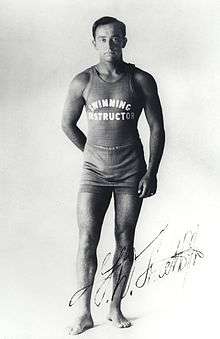George Freeth
| George Douglas Freeth Jr. | |
|---|---|
 | |
| Born |
November 8, 1883 Oahu, Hawaii |
| Died |
April 7, 1919 (aged 35) San Diego, California |
George Douglas Freeth Jr. (November 8, 1883, Oahu, Hawaii – April 7, 1919, San Diego) was an American Life Guard and Swimming Instructor credited as being the "Father of Modern Surfing".[1]
Biography
Freeth was born in Oahu, Hawaii in 1883,[2] his mother was part-Hawaiian while his father was Irish. While vacationing in Hawaii, industrialist Henry Huntington, saw Freeth surfing and quickly brought him to Redondo Beach, California in 1907 as an attraction showing off "the man who walked on water".[3] According to the 1910 Census, Freeth rented a room at 106 Pacific Avenue in Redondo Beach.[4] Freeth died at the age of 35 as a result of the global flu pandemic in 1919 while living and working in San Diego. According to his draft registration card a year earlier, Freeth was living at 1940 Abbott Street in San Diego and working as a lifeguard for the City of San Diego.[4] Upon his death, he was buried in Oahu Cemetery in a grave with his sibling, A.R. Freeth.[4] Further information taken from various descendants,[5] mentions that his mother was Elizabeth Kailikapuolono Green, daughter of William Lothian Green and Elizabeth "Lepeka" Kahalaunani, a pure Hawaiian woman. Lepeka also conceived three daughters with Archibald Cleghorn, a well-known businessman of Honolulu. Cleghorn later fathered the well-known Princess Kaiulani with Hawaiian royalty Miriam Likelike, a sister to King David Kalakaua and Queen Liliuokalani.
Lifeguard contributions
Freeth is credited by some with developing the rescue paddleboard and the rescue can, tools commonly used by lifeguards.[6] However, the United States Lifesaving Association asserts that the rescue can was designed by Captain Henry Sheffield in 1897.[7] Freeth has been reported to have received the Congressional Gold Medal for his heroic rescue of Japanese fishermen in storm conditions.[8] This is however incorrect according to the Clerk of the U.S. House of Representatives, which issues the award.[9]
Theft of bust
On August 7, 2008, it was reported that a bronze bust of Freeth was stolen from the Redondo Beach Pier where it was on display. Police had no leads at the time, but suspected that the bust was stolen to be sold for scrap metal because of its copper content.[10] On November 7, 2010, George Freeth's bust was replaced in Redondo Beach, CA.
Freeth's life and his contributions to surfing and lifeguarding is a significant part of the documentary film Waveriders.
References
- ↑ "Freeth, George". Encyclopedia of Surfing. Retrieved June 8, 2016.
- ↑ San Diego Reader | 90 Years of Curl at www.sandiegoreader.com
- ↑ Fridrich & Shanahan, Wm. & Dennis (1982). Old Redondo. Redondo Beach, California: Legends Press. ISBN 0-9608808-0-1.
- 1 2 3 "George Douglas Freeth Jr.". Ancestry.com. Retrieved March 1, 2015.
- ↑ http://www.maoliworld.org
- ↑ "Arthur Verge, Los Angeles Lifeguards". Cmp.ucr.edu. Retrieved 2013-03-22.
- ↑ Brewster, B. Chris (2003). Open Water Lifesaving, The United States Lifesaving Manual. Upper Saddle River, New Jersey 07458: Pearson Custom Publishing. p. 16. ISBN 0-536-73735-5.
- ↑ Elwell, John C.; Jane Schmauss; California Surf Museum (2007). Surfing in San Diego. Charleston, South Carolina: Arcadia Publishing. p. 12. ISBN 978-0-7385-4756-5.
- ↑ "Congressional Gold Medal Recipients | US House of Representatives: History, Art & Archives". Artandhistory.house.gov. Archived from the original on July 23, 2011. Retrieved 2013-03-22.
- ↑ Lin II, Rong-Gong (August 8, 2008). "Bust of surfing legend stolen". Los Angeles Times.
External links
- surfline.com biography
- picklehead.com biography, from American Heritage Magazine
- The unheralded god who walked on water - The Independent
- "100 years of hanging ten" - A tribute in the Los Angeles Times
- Wave Riders - a documentary exploring Freeth’s life and legacy
- Official copyright holder to the name George Freeth